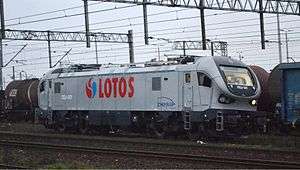Pesa Gama
| Pesa Gama | |||||||||||||||
|---|---|---|---|---|---|---|---|---|---|---|---|---|---|---|---|
 | |||||||||||||||
| |||||||||||||||
| |||||||||||||||
| |||||||||||||||
Pesa Gama is a family of diesel and electric locomotives built from 2012 by Pesa SA company. Initially, only two units have been built - the first was a universal electric locomotive with an additional diesel engine, the second was built with only a diesel powered engine. There are currently 16 locomotives in service, in 3 different versions.[1]
History
Origin
After the Second World War in Poland there were three main locomotive building companies: Fablok produced steam and diesel locomotives, Cegielski built steam locomotives, diesel and electric locomotives, and Pafawag built only electric locomotives (and also multiple units). All three companies had stopped building locomotives (and EMUs) in Poland in the 1990s. Pafawag had been building for PKP Intercity between 1997 and 2002, after being taken over by Adtranz. It built the electric locomotives EU11 and EU43, but they never reached the Polish railway tracks due to a financial problem by the client.[2]
The next Polish locomotive was only presented in 2009, when the electric cargo locomotive Dragon debuted. The locomotive was built by Newag. The next of these types of Polish locomotives were shown in 2012 at InnoTrans Trade Fair in Berlin. There Newag presented their locomotive Griffin, and Pesa showed the Gama. Both firms showed that those locomotives were just a small part of what they can offer for locomotives. Additionally in 2012 another locomotive was built, the ZPS LM-400.00 for the Warsaw Metro.[3]
In 2001, Pesa had announced that they would change their main focus from repairing locomotives to building their own locomotives. Since then in Bydgoszcz a variety of diesel and electric passenger powered locomotives, tracks and trams have been built, including modern passenger and cargo wagons.
The Gama Marathon
The first model of the family was the 111Ed Marathon locomotive. Its construction began in early 2012, and premiered on September 18 at the InnoTrans Trade Fair 2012 in Berlin. The first test drive took place in October 2012 in Bydgoszcz Wschód Station, and later on the railway lines to Inowrocław, Poznań[4] and Zduńska Wola Karsznice. The behavior of the locomotive was tested working goods trains with different loads until 25 November 2012. From 27 November 2012 to 3 December 2012 the locomotive had been tested on the track in Żmigród, reaching top speed of 173 km/h,[5] After this, the locomotive was issued with temporary certification to work passenger trains on Polish railway network at speeds up to 160 km/h, and goods trains at speeds up to 140 km/h. In order to become permanently certified for operation, the locomotive had to be tested by railway operators. On 11 January 2013 the locomotive began test service with Lotos Kolej, and later also with PKP Intercity, Pol-Miedz Trans and Orlen KolTrans. After the test service was successfully concluded, the RTO has issued the final, permanent certificate for the 111Ed (with variants 111E, 111Eb, 111Ec) locomotive on 10 July 2014.[6]
Diesel-powered Gama
In July 2014, the company built the first copy of the diesel powered Gama. The locomotive specification is compatible with the specifications of locomotives, and PKP Intercity had ordered therefore 10 units.[7] The locomotive was presented in September at InnoTrans. In mid-October the locomotive began to be tested in the second half of the month, by IPS Tabor, tests have been performed on the Rokietnica – Szamotuły railway line.[8]
PKP Intercity
Polish long distance passenger transport company PKP Intercity has taken delivery of 10 locomotives, although there have been a number of breakdowns.
References
- ↑ "Home". Pesa S.A. Retrieved 12 December 2014.
- ↑ "Świat Kolei: parowozik: magazyn sympatyków komunikacji szynowej". OCLC World Cat. Retrieved 12 December 2014.
- ↑ "Pesa Bydgoszcz History". PESA S.A. Retrieved 12 December 2014.
- ↑ "Historia". FPS Poznan (in Polish). Retrieved 12 December 2014.
- ↑ "PESA speeds up to 173 km/h". Inforail (in Polish). Archived from the original on 15 December 2014. Retrieved 12 December 2014.
- ↑ "Certificate for Pesa 111Ed (with variants 111E, 111Eb, 111Ec)". Urząd Transportu Kolejowego (Railway Transport Office) (in Polish). Retrieved 22 August 2017.
- ↑ "Hors d'oeuvres". Railvolution. Retrieved 12 December 2014.
- ↑ "Rights". Swiadectwa. Retrieved 12 December 2014.